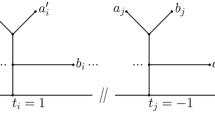Abstract
Reconstructing the evolutionary tree for a set of n species based on pairwise distances between the species is a fundamental problem in bioinformatics. Neighbor joining is a popular distance based tree reconstruction method. It always proposes fully resolved binary trees despite missing evidence in the underlying distance data. Distance based methods based on the theory of Buneman trees and refined Buneman trees avoid this problem by only proposing evolutionary trees whose edges satisfy a number of constraints. These trees might not be fully resolved but there is strong combinatorial evidence for each proposed edge. The currently best algorithm for computing the refined Buneman tree from a given distance measure has a running time of O(n 5) and a space consumption of O(n 4). In this paper, we present an algorithm with running time O(n 3) and space consumption O(n 2). The improved complexity of our algorithm makes the method of refined Buneman trees computational competitive to methods based on neighbor joining.
Access this chapter
Tax calculation will be finalised at checkout
Purchases are for personal use only
Preview
Unable to display preview. Download preview PDF.
Similar content being viewed by others
References
Bandelt, H.-J., Dress, A.W.: Reconstructing the shape of a tree from observed dissimilarity data. Advances in Applied Mathematics 7, 309–343 (1986)
Barthélémy, J.-P., Guénoche, A.: Trees and Proximity Representations. John Wiley & Sons, Chichester (1991)
Berry, V., Bryant, D.: Faster reliable phylogenetic analysis. In: Proc. 3rd International Conference on Computational Molecular Biology (RECOMB), pp. 69–69 (1999)
Berry, V., Gascuel, O.: Inferring evolutionary trees with strong combinatorial evidence. Theoretical Computer Science 240, 271–298 (2000)
Bryant, D., Berry, V.: A structured family of clustering and tree construction methods. Advances in Applied Mathematics 27(4), 705–732 (2001)
Bryant, D., Moulton, V.: A polynomial time algorithm for constructing the refined buneman tree. Applied Mathematics Letters 12, 51–56 (1999)
Buneman, P.: The recovery of trees from measures of dissimilarity. In: Hodson, F., Kendall, D., Tautu, P. (eds.) Mathematics in Archaeological and Historical Sciences, pp. 387–395. Edinburgh University Press, Edinburgh (1971)
Gower, J.C., Ross, J.G.S.: Minimum spanning trees and single-linkage cluster analysis. Applied Statistics 18, 54–64 (1969)
Gusfield, D.: Efficient algorithms for inferring evolutionary trees. Networks 21, 19–28 (1991)
Huson, D.: Splitstree: a program for analyzing and visualizing evolutionary data. Bioinformatics 14(1), 68–73 (1998), http://www-ab.informatik.uni-tuebingen.de/software/splits/welcome_en.html
Leclerc, B.: Description combinatoire des altramétriqueès. Math. Sci. Hum. 73, 5–37 (1981)
Moulton, V., Steel, M.: Retractions of finite distance functions onto tree metrics. Discrete Applied Mathematics 91, 215–233 (1999)
Nei, M., Kumar, S.: Molecular Evolution and Phylogenetics. Oxford University Press, Oxford (2000)
Saitou, N., Nei, M.: The neighbor-joining method: A new method for reconstructing phylogenetic trees. Molecular Biology Evolution 4, 406–425 (1987)
Schönhage, A., Paterson, M.S., Pippenger, N.: Finding the median. Journal of Computer and System Sciences 13, 184–199 (1976)
Author information
Authors and Affiliations
Editor information
Editors and Affiliations
Rights and permissions
Copyright information
© 2003 Springer-Verlag Berlin Heidelberg
About this paper
Cite this paper
Brodal, G.S., Fagerberg, R., Östlin, A., Pedersen, C.N.S., Rao, S.S. (2003). Computing Refined Buneman Trees in Cubic Time. In: Benson, G., Page, R.D.M. (eds) Algorithms in Bioinformatics. WABI 2003. Lecture Notes in Computer Science(), vol 2812. Springer, Berlin, Heidelberg. https://doi.org/10.1007/978-3-540-39763-2_20
Download citation
DOI: https://doi.org/10.1007/978-3-540-39763-2_20
Publisher Name: Springer, Berlin, Heidelberg
Print ISBN: 978-3-540-20076-5
Online ISBN: 978-3-540-39763-2
eBook Packages: Springer Book Archive




